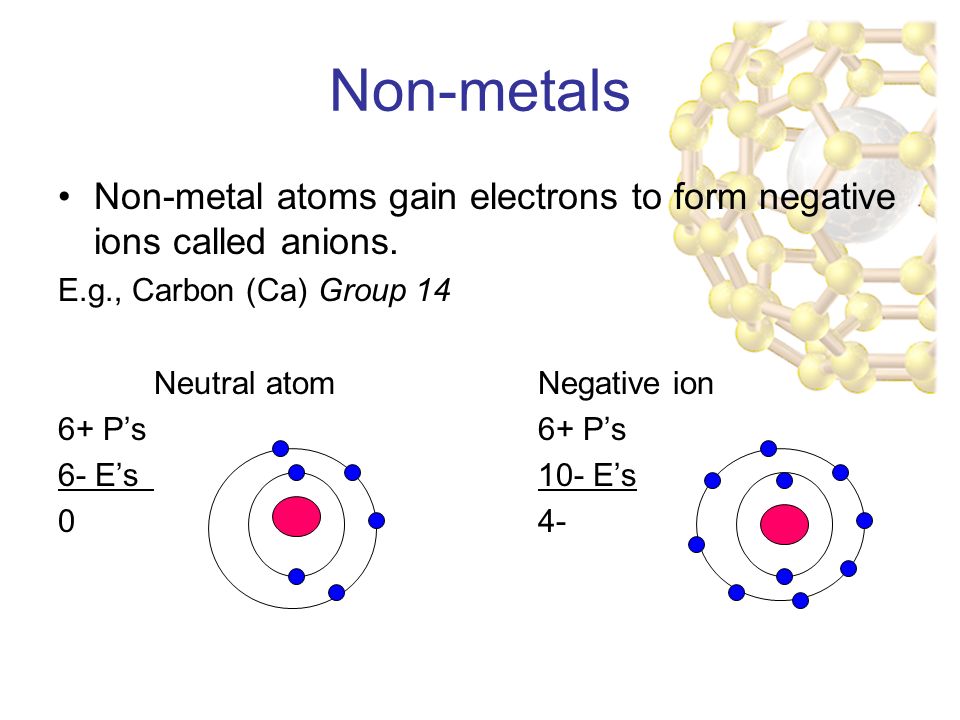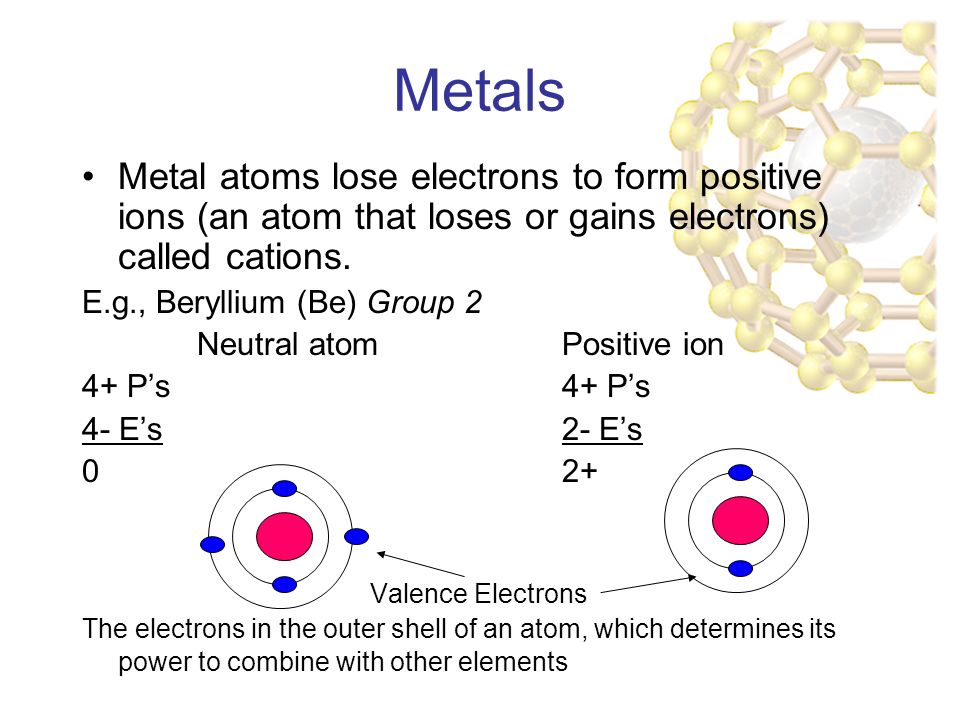Metal Atoms Always Form the Type of Ions Called
How cation is formed. The relative number of atoms of each element in a given compound is always the same and is a characteristic of the compound.

Chemical Bonding Ionic Bonds Ionic Bonds Are Made Between Metal And Non Metal Atoms Electrons Are Transferred From The Metal Atom To The Non Metal Atom Ppt Download
The resulting compound is called an ionic compound.

. What Type Of Elements Form CationsHalogens always form anions alkali metals and alkaline earth metals always form cations. Only metal atoms B. When metals react with non-metals electrons are transferred from the metal atoms to the non-metal atoms forming ions.
The metal atoms become positive ions and the non-metal atoms become negative ions. The smallest particles of. Ionic bonds form between two or more atoms by the transfer of one or more electrons between atoms.
Depending upon the chemical circumstances metal atoms are able to form more than one type of ion and is called variable charge metal. Metal elements form positively charged ions called cations because they are located on the left side of the periodic table. Oxygen carbon sulfurAug 15.
Groups 1 and 2 are called the alkali metals and alkaline Earth metals respectively. Group 1 and group 2 are called the alkali metals and alkaline earth metals. Also Know why do metals form cations.
The smallest particle of a covalently bonded substance that have all the properties of that substance is called a _____. Anions are one of the two types of ions. A positively charged ion is called a cation it is produced when one or more electrons are LOST from a neutral atom if an atom loses two electrons the ion it creates has a 2 charge because now there are two more protons with a positive charge than there are electrons with a.
When a metal reacts with a nonmetal an ionic compound is produced and the formula of the compound would be AX 2 alkaline earth metals form 2 ions and halo-gens form 1 ions in ionic compounds. Metal elements form positively charged ions called cations because they are located on the left side of the periodic table. Atoms are neither created nor destroyed in a chemical reaction.
Iron silver nickel whilst most other nonmetals typically form anions eg. Transfer of electrons. Metal elements form positively charged ions called cations because they are located on the left side of the periodic table.
When this happens the atoms become oppositely charged ionsIonic. Here NaCl is ionic and carbon dioxide is binary compound. If a metal element forms an ion it always forms a cation.
Atoms gain electrons to form negatively charged ions. Most other metals form cations eg. Atoms that gain electrons non-metals form negative ions anions.
The type of ions that metals form are called positively chargedions. Metal atoms become positively charged ions because they lose electrons when they react with another atom. Negatively charged ions called _____ result from gain of electrons.
A metal atom and a nonmetal atom. Most other metals form cations eg. Principles of Organic Chemistry 2015 Ionic Bonds.
The metal ion always has positive charge and the non-metal ion always has negative ion called binary compounds. Groups 1 and 2 are called the alkali metals and alkaline Earth metals respectively. Ionic bonds always form between metals and _____ nonmetals.
Ions result from atoms or molecules that have gained or lost one or more valence electrons giving them a positive or negative charge. Atoms that lose electrons metals form positive ions cations. Groups 1 and 2 are called the alkali metals and alkaline Earth metals.
Metal elements form positively charged ions called cations because they are located on the left side of the periodic. Halogens always form anions alkali metals and alkaline earth metals always form cations. When an alkaline earth metal A reacts with a halogen X the formula of the ionic compound formed should be AX 2.
The correct statement would be. Some metals always form the same type of cation. Metals always form positive ions and non-metals form negative ions due to the amount of electrons in the outer shell highest energy level.
Atoms lose electrons to form positively charged ions. Cations are the positive ions formed by the loss of one or more. An ionic bond is the force of attraction that holds together oppositely charged ionsIt forms when atoms of a metal transfer electrons to atoms of a nonmetal.
Most metal atoms have only one or two valence electronselectrons which if removed would leave the atom with a filled shell at the. These elements all have valence electrons in an s orbital. These metal atoms have valence electrons in an s orbital.
Only non-metal atoms C. For example sodium always forms a 1 cation and magnesium always forms a 2 cation. These ions attract each other.
These elements all have valence electrons in an s orbital. The scientific name for positively charged ions iscations. Atoms of two or more elements can combine to form a compound in which the atoms are not changed to different types of atoms or fractions of atoms.
Metals are situated on the left side of the periodic table. Iron silver nickel whilst most other nonmetals typically form anions eg. The other type is called a Cation having a positive charge.
And they losegain electrons which are negative. Electron transfer produces negative ions called anions and positive ions called cations.

Chemical Bonding Ionic Bonds Ionic Bonds Are Made Between Metal And Non Metal Atoms Electrons Are Transferred From The Metal Atom To The Non Metal Atom Ppt Download

Metal Atoms Lose E To Form Positive Ions Called Cations K Ca 2 Nh 4 Nonmetal Atoms Gain E To Form Negative Ions Called Anions Cl S 2 Co Ppt Download

Comments
Post a Comment